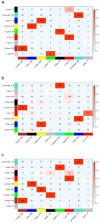K-Module Algorithm: An Additional Step to Improve the Clustering Results of WGCNA Co-Expression Networks
- PMID: 33445666
- PMCID: PMC7828115
- DOI: 10.3390/genes12010087
K-Module Algorithm: An Additional Step to Improve the Clustering Results of WGCNA Co-Expression Networks
Abstract
Among biological networks, co-expression networks have been widely studied. One of the most commonly used pipelines for the construction of co-expression networks is weighted gene co-expression network analysis (WGCNA), which can identify highly co-expressed clusters of genes (modules). WGCNA identifies gene modules using hierarchical clustering. The major drawback of hierarchical clustering is that once two objects are clustered together, it cannot be reversed; thus, re-adjustment of the unbefitting decision is impossible. In this paper, we calculate the similarity matrix with the distance correlation for WGCNA to construct a gene co-expression network, and present a new approach called the k-module algorithm to improve the WGCNA clustering results. This method can assign all genes to the module with the highest mean connectivity with these genes. This algorithm re-adjusts the results of hierarchical clustering while retaining the advantages of the dynamic tree cut method. The validity of the algorithm is verified using six datasets from microarray and RNA-seq data. The k-module algorithm has fewer iterations, which leads to lower complexity. We verify that the gene modules obtained by the k-module algorithm have high enrichment scores and strong stability. Our method improves upon hierarchical clustering, and can be applied to general clustering algorithms based on the similarity matrix, not limited to gene co-expression network analysis.
Keywords: connectivity; distance correlation; enrichment analysis; gene co-expression networks.
Conflict of interest statement
The authors declare no conflict of interest.
Figures





Similar articles
-
KISL: knowledge-injected semi-supervised learning for biological co-expression network modules.Front Genet. 2023 May 2;14:1151962. doi: 10.3389/fgene.2023.1151962. eCollection 2023. Front Genet. 2023. PMID: 37205122 Free PMC article.
-
TPSC: a module detection method based on topology potential and spectral clustering in weighted networks and its application in gene co-expression module discovery.BMC Bioinformatics. 2021 Oct 25;22(Suppl 4):111. doi: 10.1186/s12859-021-03964-5. BMC Bioinformatics. 2021. PMID: 34689740 Free PMC article.
-
Use of a graph neural network to the weighted gene co-expression network analysis of Korean native cattle.Sci Rep. 2022 Jun 14;12(1):9854. doi: 10.1038/s41598-022-13796-9. Sci Rep. 2022. PMID: 35701465 Free PMC article.
-
Learning Differential Module Networks Across Multiple Experimental Conditions.Methods Mol Biol. 2019;1883:303-321. doi: 10.1007/978-1-4939-8882-2_13. Methods Mol Biol. 2019. PMID: 30547406 Review.
-
Comparison of Methods for Differential Co-expression Analysis for Disease Biomarker Prediction.Comput Biol Med. 2019 Oct;113:103380. doi: 10.1016/j.compbiomed.2019.103380. Epub 2019 Aug 10. Comput Biol Med. 2019. PMID: 31415946 Review.
Cited by
-
A hypoxia-related prognostic model predicts overall survival and treatment response in hepatocellular carcinoma.Biosci Rep. 2022 Nov 30;42(11):BSR20221089. doi: 10.1042/BSR20221089. Biosci Rep. 2022. PMID: 36314455 Free PMC article.
-
Identification of biomarkers related to neutrophils and two molecular subtypes of systemic lupus erythematosus.BMC Med Genomics. 2022 Jul 20;15(1):162. doi: 10.1186/s12920-022-01306-9. BMC Med Genomics. 2022. PMID: 35858908 Free PMC article.
-
Construction of a prognostic prediction model for renal clear cell carcinoma combining clinical traits.Sci Rep. 2023 Feb 27;13(1):3358. doi: 10.1038/s41598-023-30020-4. Sci Rep. 2023. PMID: 36849551 Free PMC article.
-
KISL: knowledge-injected semi-supervised learning for biological co-expression network modules.Front Genet. 2023 May 2;14:1151962. doi: 10.3389/fgene.2023.1151962. eCollection 2023. Front Genet. 2023. PMID: 37205122 Free PMC article.
-
Hypergraph-based analysis of weighted gene co-expression hypernetwork.Front Genet. 2025 Apr 4;16:1560841. doi: 10.3389/fgene.2025.1560841. eCollection 2025. Front Genet. 2025. PMID: 40255486 Free PMC article.
References
Publication types
MeSH terms
LinkOut - more resources
Full Text Sources
Other Literature Sources

